 |
||
|
||
| ||
Market noveltiesAfter the Christmas and New Year holidays manufacturers have announced a whole bunch of new devices. For example, Dieceland Technologies has presented a device, which is going to be released on the market this year. It's a Phone-Card-Phone made of the recycled paper, which will cost approximately $10 (including the first 60 minutes of operation) and which, as the company considers, will be sold together with usual daily stuff. As I understand, the phone is supposed to operate with outgoing calls only, all other variants are theoretically possible, but still, practically useless.   In the meantime, one of the brands, namely Ericsson, continues to "mess" with PDAs: the company has created the Communicator Platform prototype, that has all latest features inside: PDA with built-in GPS system, WAP and HTML support; Bluetooth; the announced bandwidth is 7,1 Mbit/s that must be quite enough even for streaming video. It's just like a communicator from sci-fi movies of the recent past. Another brand phone manufacturer, the Nokia company, is going to release for sale in March or April the new 9210 Communicator PDA/telephone with the color display and also with Symbian OS, considerably outrunning releases of similar models with Microsoft's OS. Microsoft representatives say that the similar devices from Nokia's competitors will appear in the market not earlier than the second half of the year. The popularity of twisting information devices with telephones is continuously testified by always increasing number of companies releasing new versions of similar devices on the market. The Eishi company has released an I-P88 smartphone, combining PDA and dual-standard GSM900/1800 telephone features. With its rather small size (120X78X23 mm) and weight of 210 grammes it is the smallest smartphone of such class for today. Large touch display with 320X240 resolution, vibrocaller, WAP 1.1 support and the possibility of executing JAVA applications make this device very interesting. It is also known that idle operating time will make from 50 to 150 hours, and talk time - from 120 to 210 minutes; the device works with built-in lithium battery. Unfortunately, there are no more details yet. 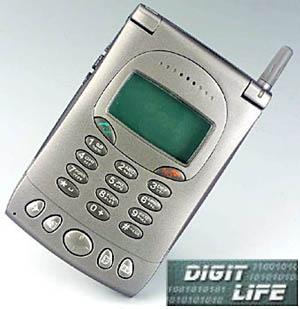 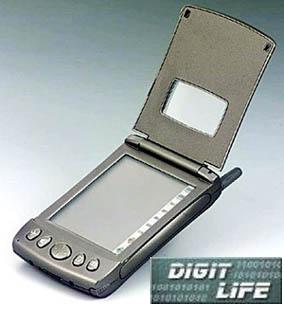 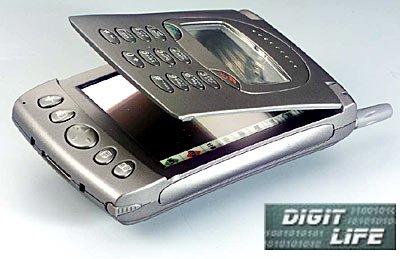 In the meantime, Mitsubishi company has presented the similar device in Europe. It is Trium Mondo. 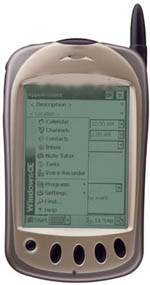 Quite good design, average monochrome screen size, mail client, WAP 1.1 browser and SMS-pager create a good impression about new headline model from Mitsubishi. The most interesting info about smartphones is surely the announcement by the FutureCom Global company of the forthcoming release of the hybrid device which has been named PC-EPHONE, combining functions of electronic organizer, mobile telephone and multimedia device. Its presentation took place at the Consumer Electronics Show in Las Vegas on January 6, 2001. This device works under Windows CE. Its sizes are 12.7X10.2X2.5 cm. The device is equipped with a 206 MHz processor, 16 MBytes of RAM, 32 MBytes of ROM, 4-inch touch LCD-display with backlight supporting 256 colors, Compact Flash slot and serial port. The device is powered a lithium-ion accumulator.  The PC-EPHONE can playback MP3s and MPEGs; built-in mobile features allow to work in CDMA, AMPS, PCS and GSM networks, Bluetooth resources are also supported. GPS and digital camera additional modules can also be connected to the Compact Flash port. The PC-EPHONE hybrid is developed by the Korean Cyberbank company, it will be manufactured on the basis of OEM-agreement by the Samsung company, and FutureCom Global will become cordless services operator for these devices. The prices and shipping dates are not known yet, but the additional information should appear in the first quarter of 2001. The Samsung company has presented in January the prototype of a hybrid PDA+mobile phone device. The smartphone from Samsung (even the model number is unknown for now) will work under Palm OS and will be released in the middle of this year. It will not use a usual Palm browser, but the browser from the Espial company, based generally on Java. The software from Espial will be used also for Internet videocalls. The same time the Korean corporation plans to present telephone+watches devices. I shall remind that similar devices have already been presented by Mitsubishi, Motorola and Sagem. It is also possible to relate here the Handspring Visor with GSM-unit. In January the GeoDiscovery company, one of the leading GPS equipment manufacturers, has declared availability of its GPS SpringBoard unit for Visor - Geode GPS Module, and the GeoView software for it, allowing to easily edit and create maps, and also free maps from the site. The unit contains two MultiMediaCard slots, that potentially allows to store up to 64 Mbytes of geographical maps. The approx. price is $289. 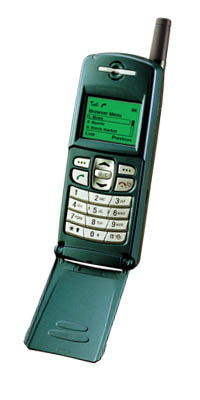 But we shall return to the Samsung company. It has presented in January a new EGSM900/1800 cellular telephone model for the Russian market - SGH-N100. The telephone is featured by small sizes and small weight - only 83 grammes. New N-100 is equipped with a WAP-browser, vibrocaller, Li-Ion battery, multifunction alarm clock, organizer, voice calling and hand-free functions, dictaphone, and 11 different games. The company positions the new model as the business-class telephone; official sales in Russia are planned to begin as soon as possible, though the price is not known yet. According to some information, the device will cost about $250. According to representatives of Samsung, the company will present in 2001 about 6 new cellular telephones for the Russian market, including inexpensive models for masses. In particular, it is the R100 model, which was named N600 earlier and was oriented to the low market segment. It is necessary to mark following features: dual-standard, small weight (99 grammes), size of 113 x 48 x 22 mm, large graphics 128x64 display, up to 5 lines of text, WAP 1.1 browser, and also capability of logos/tunes loading. 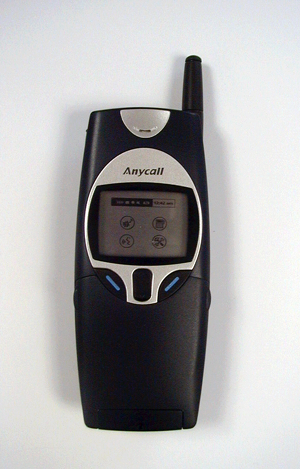 Another interesting model is the Q100. It is the first Samsung telephone with GPRS support. By the current moment there are only prototypes with no real GPRS support, but it is quite probable that in some months some more efficient versions will appear. Other characteristics are good: the 128x128 display, 7-11 lines of text on the screen, 4-shade grayscale, weight of 85 grammes, size of 112x42x18.5mm. Naturally, it's dual-standard with WAP support, and I think it also looks nice. 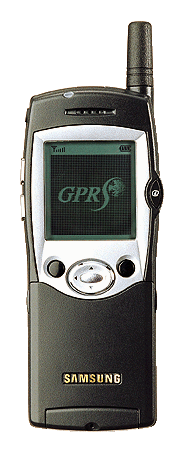 The release of another GPRS phone - VGP - is expected by the end of the year, to be more exact: by the end of the third quarter. Features: size of 109X44X17mm, weight of 95 grammes, but the same Li-Ion battery, as well as same functionality. 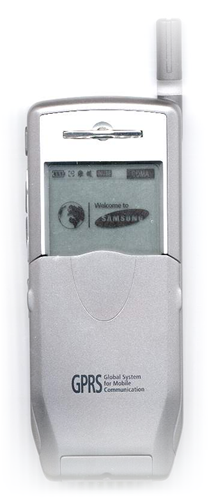 Two new models will be presented in the average device class: SGH-N300 and SGH-A300. Unfortunately, there are no pics of them, but here are some characteristics. Weight of the first telephone is 85gr, size is 112X42X18.5mm; there is also an IR-port, logos/tunes loading feature, WAP 1.1 browser. The second model is much more interesting: besides from IR-port, it has two displays - one outside, another inside. As you may have already guessed, this telephone a so-called "fold-in-two" model made to replace A100/A110. Weight is 89 grammes with the thin battery, sizes are 83.5x44x14.4mm. The package is supposed to be almost the same as for À100 and will include two accumulators, cable and a velvet box for the telephone. However, you can look and at other "folder" to be released in the end of the year. It is Q200. 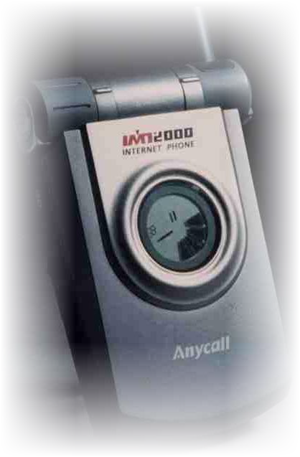 Now let's distract from novelties for some time. The Guinness Book of Records in this year was enlarged by two products of Samsung Electronics. It is the smallest television receiver, built into the mobile telephone, and watches with the integrated cellular terminal. The TV-phone (SCH-M22) represents a combination of the TV-set and a cellular telephone and provides 200 minutes of television programs streaming, 180 hours in cellular telephone idle mode and 170 minutes of talking. In spite of the fact that "cellular watches" were also developed by the Japanese NTT DoCoMo company, Motorola and Swiss Swatch, the publishers of the Guinness Book of Records have chosen Samsung Electronics as the first company to present the Watch-phone (SPH-WP10) for production. You can store up to 250 telephone numbers in a built-in notepad of the model offered by Samsung. Watch phone is the smallest and the lightest CDMA-telephone that you can wear on hand like usual watches. But it's not the first record of the company: in 1999 Samsung's semiconductors production has been recognized as the most ecologically clean in the world, and in 2000 Samsung has been recognized as the company with the highest industrial safety. But let's finish talking about smartphones. The Broadbeam company, one of the leading American suppliers of the GSM and GPRS-networks equipment, has announced that its equipment will henceforth support the new EPOC 32mobile operating system from Symbian whose predecessors can be found in many smartphones and GSM-PDA devices (PSION Series 5MX, netBook). The support of Symbian's EPOC 32 will allow to use all features of this operating system (fast message transfer, digital signature, filters, message coding, etc.). The implantation of the new equipment will take place both in Europe and in America. By the way, the greatest percent of Symbian shares belongs to Nokia, Ericsson, Psion, Motorola and Matsushita. And WAP seems to be really good. Digital Airways has presented in January a WAP-microbrowser Wapaka, written on Java, and therefore being the Java-applet. With the help of this simple (100 KB) applet you can see how this or that site will look on your mobile telephone or PDA. Originally this product was intended for web-designers wishing to create WAP-version of the site. The applet, in common, is a smart one. It provides complete WAP 1.1 compatibility, has many settings and can be improved by support of new protocols (WAP 1.2, i-Mode). The French SAGEM company has presented the new gamma of mobile telephones - SAGEM 3000 series, which have already begun to arrive to Europe distributors since January 31, 2001. SAGEM 3000 is a line of dual-band mobile telephones for any taste: all models have possibility to load popular melodies, change color of the front panel, to user-program buttons. The dual-band (GSM 900/1800) SAGEM 3000 series are equipped with WAP support. 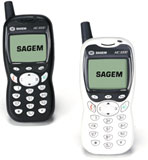 The SAGEM MC 3000 model represents light (112gr) small (105 mm in length) telephone equipped with vibrocaller, memory for 10 SMS messages, telephone book for 40 numbers, 43 built-in and 5 loaded melodies, hands-free, and also complete function set for the modern mobile telephone: a calendar, currency converter, date, time, voice mail, alarm clock, etc.. The accumulators allow to talk for 1 hour 45 minutes or about 6 days of idle mode. Another model is the SAGEM WA 3050 is nothing more than a smartphone - a combination of a cellular telephone with GPRS and PDA. The model is equipped with 16 Mbytes of memory and allows to receive email, supports WAP and HTML, is able to process data with the help of Microsoft Pocket Word and Microsoft Pocket Excel, and also allows to use an organizer and multimedia applications. SAGEM WA 3050 is equipped with the touch panel for hand-writing and an infrared port for linking to the PC or another PDA. At a size of the screen of 60X80 mm (240X320 of pixels) and a built-in digital dictaphone the weight of novelty makes only 200 grammes. 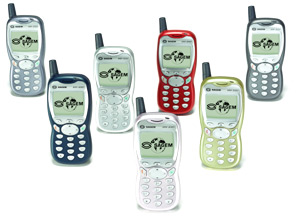 The "lesser" SAGEM MW 3020 model is equipped with the intuitive interface allowing to receive information about weather, news, share prices, etc. with the help of a WAP-browser and several pre-assigned keys. The screen is capable of up to 8 lines of text. The telephone is equipped with WAP 1.1 browser, built-in games, memory for 10 SMS messages and 50 telephone numbers. The weight of a novelty is 112 grammes. One of the most considerable news of the past month is the one about antennas for cellular telephones. Roger Green from Warwick University has developed the special antenna that works in all directions, except those 120-160 degrees "pointing" to a human head. Thus the electric waves effecting on a head are reduced for 97 %. Furthermore, narrowing the angle improves the power of useful signal. The only minus is the loss of signal in fast moving and changing directions transport, (trains, for example) or if you stand with your head to the transmitter. But that doesn't happen in cities in the most cases. Roger Green now searches for the companies, which will pay attention to his development. It seems that Nokia has already become interested in this antenna. At the same time American scientists from Lucent Technologies Bell Labs have detected an effect, which can be used to compact the size of the portable information. This effect will help to increase, for example, the number of cellular network channels in big cities. The scientists have researched radiowaves "behavior" in densely built-up regions and came to the concept of 3D transmitter. With the help of the special equipment under condition of transmitter and receiver set-up for operation with signals, polarized in three dimensions, there is a possibility to thricely obturate already existing data channels. The experts have developed such equipment and have connected three antennas to the receiver and the same to the transmitter located under right angles to each other. Simultaneously transmitting different signals from each of antennas, they have detected that due to different polarization it is possible to transmit three independent trunks, using one equipment package. Demonstrating the 3D cordless system, scientists transmitted the image of a painting over 25m distance and the receiver was not in a line of sight. The data was transmitted three times faster than with the usual equipment, as three different channels with different polarization were used. The researchers from university of Northern Carolina have found a way of struggle with fading of radio signals in mobile networks. Almost all mobile phone users met with problem of fading, sudden amplification or traffic interruption of voice transmission. The similar problems also arise in case of cordless transmission of the digital data, videostreams or multimedia information. It was considered until now that it is impossible to struggle with it because of random and unpredictable nature of radio signal fluctuations. However now it is known that signal fluctuations can be predicted and watched over even before they have taken place. The scientists have developed the so-called adaptive prediction algorithm of signal fading in radio channels on long distances, which allows to predict radio signal fading or fluctuation some milliseconds before it actually occurs. This time can be enough for antennas to magnify signal or for transmitters to set for other frequencies. The advanced development has interested the scientists and engineers from the companies occupied with creation of new technologies in the field of mobile communication. The algorithm of fading and its physical analog are still in stage of research. Now let's return to market novelties. The advanced design of Benefon and Vitaphone - Cardiophone telematic medical system has been presented at the Medica medical exhibition in Dusseldorf. Cardiophone is the result of joint scientific researches of these companies and is intended for treatment of people with high risk of heart attacks. As the technical fundamentals the system uses version of Benefon Track (GSM+GPS) specially designed for Vitaphone in Herz Handy variant, that is a unique combination of the multifunction GSM telephone, GPS receiver and MPTP-protocol (Mobile Phone Telematics Protocol). The main functions of Cardiophone are logging data about health status of the patient and its transmission to national Vitaphone medical centre with the help of GSM network and GPS system. The procedure is simple. The user puts Cardiophone with the back side to the left-hand side of his/her breast and cardiogram is ready. The result together with precise coordinates of the user is routed to Vitaphone medical service center, where the medics, parsing obtained data, put the diagnosis and decide what to do. Vitaphone plans to begin commercial allocation of the service in the beginning of 2001 in Germany and hereinafter in other countries of Europe. Now Vitaphone already carries out field trials of the system with application of Herz Handy devices released by Benefon. The total sum of the initial contract between the sides for the term since November '2000 till June '2001 is equal to 22 million euros. 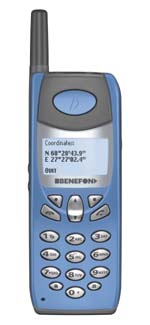 In general Benefon Track was earlier named "Locus", and that was refused because this word was dissonant for german people and the contract was to be held in Germany. These earphones can surely be named as another interesting product of January. 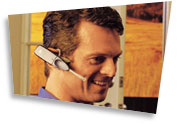 The ArialPhone company has released a portable device, which can be related to a category of mobile earphones. This device is named ArialPhone. It weighs about 30 grammes. Besides possibility to talk via this device with both hands free, it has the function of speech recognition, that allows to control its operation with the help of voice commands, for example to voice-dial a telephone number or name of the person that user is going to call. Besides, there are computer communication resources controlled by voice. Such telephone is designed for very occupied people first of all. Hereinafter this device is supposed to control consumer electronics functions. For example, with the help of voice commands it will be possible to switch channels on the TV set, to record television programs, to control music-players, set-top box and cable modems and also to turn on/off light in the house. The ArialPhone system consists of the "phone-earphone" working on 900 MHz frequency, the base station and built-in software. But the base station must be connected to a PC via USB-port to perform necessary operations. The second cable from a base station is connected to the usual telephone socket. The distance between the telephone and computer should not exceed 50m, so you can move around the house or flat in reasonable limits. There are neither screen, nor keyboard on the "earphone". There is only one button, pressing on which the computer receives a signal about the forthcoming voice command from the user. Speech recognition resources available in ArialPhone work irrespective of user voice and "understand" natural continuous speech, without any preliminary "training". The software, which the telephone ArialPhone is equipped with, can work with the contact information written in Microsoft Outlook and Outlook Express. The prices and specific dates of shippings are unknown for now. How do you think, what is necessary for streaming video on the mobile telephone? A good display only. The Seiko Epson Corp. company has informed about the beginning of commercial implementation of the project of releasing TFD-LCD color transparent MD-TFD panels with low power consumption for mobile telephones with possibility of streaming video. The panels will have size of 2" (5,1 cm) in diagonal with 132X162 resolution. The power consumption of new LCD-panels will make only 1 milliwatt in the idle mode, 2,5 milliwatt in the text mode and 4 milliwatt in the video mode. According to the company, it was possible to build video memory and consumed energy indicator into the panel. The MD-TFD panel shows up to 4096 colors with the contrast ratio of 20:1; the time of matrix refresh is 60 ms, the size is 39,9x48,7, built-in backlight is also present. At the same time Korean Kumho Electric has announced the beginning of mass production of backlight lamps for LCD screens on the basis of the cold cathode technology. The company, which has completed creation of production line for 1.5 million lamps per month, declares that, according to tests of the Japanese manufacturers, its lamps provide twice greater operation time than usual light sources for similar applications with the same batteries charge. Write a comment below. No registration needed!
|
Platform · Video · Multimedia · Mobile · Other || About us & Privacy policy · Twitter · Facebook Copyright © Byrds Research & Publishing, Ltd., 1997–2011. All rights reserved. |